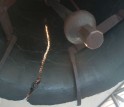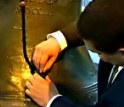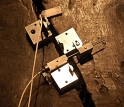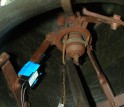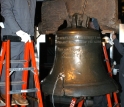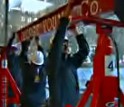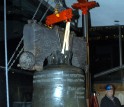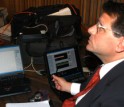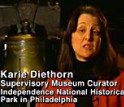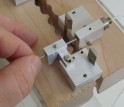News Release 03-037
Liberty Bell Passes Stress Test
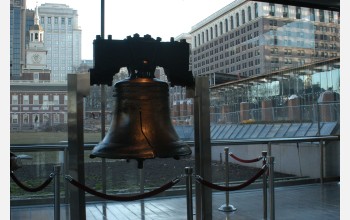
The Liberty Bell in its current pavilion located on Market Street in Philadelphia, Pennsylvania.
April 1, 2003
B-roll is available in BetacamSP, contact Dena Headlee, 703-292-7739, or dheadlee@nsf.gov.
This material is available primarily for archival purposes. Telephone numbers or other contact information may be out of date; please see current contact information at media contacts.
How do you move a wounded, 2,080-pound patriot? Very carefully. Recently, under the watchful eyes of curators, conservators, surveyors, and engineers, a team of riggers deftly lifted the fragile Liberty Bell off of the supports on which it has been resting for a quarter century and confirmed the Bell can be safely moved into its new home this fall.
Recognizable across the globe with its famous crack, the 250-year-old bell is remarkably frail for its size. The metal is far from pure. Rather, it is a mixture of various metals, voids and contaminants, intermingled "like a piece of fruitcake," said Karie Diethorn, Supervisory Museum Curator at Independence National Historical Park in Philadelphia. The park is operated by the National Park Service.
Of particular concern is a hairline fracture that extends from the main crack to the rear of the Bell--if the hairline fracture splits, so does the icon.
"In terms of assessing its fragility, we really don't know, so our plan is to subject it to the least amount of stress possible," said Diethorn.
The Liberty Bell has traveled several times, even across the country, before settling in the 1976 Bicentennial facility where it now rests. The latest move will bring the Bell closer to Independence Hall, its original home.
Although the Bell will move only 200 yards into the new museum, curators are taking every precaution to assure its safety. Steve Arms, president of MicroStrain, Inc. tracked movements of the metal along the crack using tiny, wireless sensors he developed as part of the NSF Small Business Innovation Research program. The devices are extremely sensitive, able to detect motion as small as 1/100th the width of a human hair.
The researchers used custom attachments to place two metal sensors, originally developed for the semiconductor industry, on the metal around the Bell's main crack. One sensor monitored stresses that could widen the crack, another monitored stresses from shearing motions. Stresses along the main crack will warn of dangers that could spread to the hairline fracture. The team also hung a third sensor inside the Bell to monitor potentially jarring rocking motions.
The Bell surface is extremely sensitive to both scratching and chemical damage, so the team could not use glues or directly touch metal to metal. Ultimately, Andrew Lins, chief conservator of the Philadelphia Museum of Art, worked with MicroStrain's Steven Mundell to carefully clamp the devices to the Bell, inserting a special paper where the sensors would otherwise touch, and potentially mar, the surface.
Fortunately, Arms's sensors detected no motions greater than several millionths of a meter, tiny movements that do not seem to stress the Bell.
"We can use the data that we collected to create upper and lower limits for vibration, and sound an alarm during the move to warn the riggers if the limits are exceeded," said Arms. "That will allow us to move the bell to the new location and basically mimic the conditions that we got here today, which we feel are safe." he added.
Because of the nature of the move, all of the technology had to be small and wireless. Despite these restrictions, the devices are capable of continuously streaming enormous amounts of data to a laptop that Arms monitored at the site. However, the proprietary software is web compatible, so all of the monitoring could theoretically have been done from anywhere in the world.
MicroStrain's work with the Liberty Bell, and all of the stress sensors and equipment, were provided pro bono. "I just thought this would be a fun project to take on, and a challenging one," said Arms, "we wanted to try to protect a national treasure."
The Liberty Bell was forged in 1752 at Whitechapel Bell Foundry in England--the same foundry that forged Big Ben (the 13-ton and, ironically, cracked bell within the Great Clock of Westminster) and the bells of Washington National Cathedral.
According to historians, the Pennsylvania Assembly probably ordered the Bell in 1751 to commemorate the 50th Anniversary of Pennsylvania's Charter of Privileges, religious and political freedoms that the state had enjoyed since its founding. The Assembly asked for the biblical inscription: Proclaim Liberty throughout all the Land Unto all the Inhabitants thereof - Leviticus 25:10.
The Bell was to hang in the clock tower of the Pennsylvania State House. The State House was later renamed Independence Hall, and the Bell--once known as the State House bell--was renamed "Liberty Bell" by abolitionists who adopted it as their symbol in the 1800s.
The Bell cracked soon after its arrival in Philadelphia and was recast (from the original metal) by local craftsmen John Pass and John Stow in 1753. Even that casting had problems, and the Bell that now rests in the display hall is the third casting.
Over the next century of continual use, a crack had begun to form that had to be filed down to prevent a jarring noise when the Bell was struck (the filing marks are still apparent today). In February, 1846, the Bell was repaired and rung in commemoration of George Washington's birthday. The repair is visible today as a wide jagged crack spanned in two places by rivets. While it once rang the pitch of E-flat, the Bell has not pealed since 1846.
-NSF-
-
A view of the famous crack as viewed from within the Liberty Bell.
Credit and Larger Version -
Andrew Lins worked with Steven Mundell to carefully clamp sensor devices to the Liberty Bell.
Credit and Larger Version -
View Video
The Liberty Bell Video, Segment 1: Attaching Sensors
Credit and Larger Version -
A close-up view of the MicroStrain NANO-DVRT wireless sensors clamped to the Liberty Bell.
Credit and Larger Version -
A close-up view of the spider, a structural brace that helps the Bell support its own weight.
Credit and Larger Version -
Riggers carefully position tackle that will be used to hoist the Liberty Bell.
Credit and Larger Version -
View Video
The Liberty Bell Video, Segment 2: "Riggers Prepare for Lifting"
Credit and Larger Version -
View Video
The Libery Bell Video, Segment 3: "Lifting the Liberty Bell"
Credit and Larger Version -
The Liberty Bell hangs after being hoisted out of its supports.
Credit and Larger Version -
MicroStrain president Steve Arms monitors the sensor data as the Bell is lifted.
Credit and Larger Version -
Steve Arms conducts initial measurements on the Liberty Bell.
Credit and Larger Version -
View Video
The Liberty Bell Video, Segment 4: "Comments from Steve Arms, President, MicroStrain, Inc."
Credit and Larger Version -
View Video
The Liberty Bell Video, Segment 5: "Comments from Karie Diethorn"
Credit and Larger Version -
Wooden model of the Liberty Bell crack which the researchers used to design the sensor mounts.
Credit and Larger Version
Media Contacts
Joshua A. Chamot, NSF, (703) 292-7730, email: jchamot@nsf.gov
Lynne McMinn, Public Relations, MicroStrain Inc, (802) 326-4215, email: lmmcminn@together.net
Phil Sheridan, Public Affairs Officer, Independence National Historical Park, (215) 597-0060, email: phil_sheridan@nps.gov
Program Contacts
Kesh S. Narayanan, NSF, (703) 292-7076, email: knarayan@nsf.gov
Related Websites
Special Report: The Liberty Bell, Protecting an American Icon: http://www.nsf.gov/news/special_reports/liberty/
Official National Park Service Web site on the Liberty Bell: http://www.nps.gov/inde/liberty-bell.html
MicroStrain Web site: http://microstrain.com
Big Ben at Whitechapel Foundry Web site: http://www.whitechapelbellfoundry.co.uk/bigben.htm
The U.S. National Science Foundation propels the nation forward by advancing fundamental research in all fields of science and engineering. NSF supports research and people by providing facilities, instruments and funding to support their ingenuity and sustain the U.S. as a global leader in research and innovation. With a fiscal year 2023 budget of $9.5 billion, NSF funds reach all 50 states through grants to nearly 2,000 colleges, universities and institutions. Each year, NSF receives more than 40,000 competitive proposals and makes about 11,000 new awards. Those awards include support for cooperative research with industry, Arctic and Antarctic research and operations, and U.S. participation in international scientific efforts.
Connect with us online
NSF website: nsf.gov
NSF News: nsf.gov/news
For News Media: nsf.gov/news/newsroom
Statistics: nsf.gov/statistics/
Awards database: nsf.gov/awardsearch/
Follow us on social
Twitter: twitter.com/NSF
Facebook: facebook.com/US.NSF
Instagram: instagram.com/nsfgov



